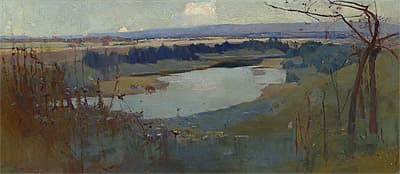Sydney
LONG
Australia
1871
–
London
1955
England, Europe 1910-21; Australia 1921- 22; England 1922-25; Australia 1925-52; England from 1952
25.4 (h) x 55.8 (w) cm
signed ‘SID LONG’ lower left Collection: Tasmanian Museum and Art Gallery Tasmanian Museum and Art Gallery, Hobart, purchased with funds from the Robb Bequest 1981
Long painted The river from the top of a natural rise overlooking the upper reaches of the Hawkesbury River, in the same year and in roughly the same location that Arthur Streeton painted his much admired Hawkesbury River subjects. The composition, however, is closer to that in Streeton’s image of the Yarra River and distant Dandenong Ranges in ‘Still glides the stream, and shall forever glide’ 1890. Long would have known of this work from 1890 when the Art Gallery of New South Wales purchased it.
In both paintings there is a large stretch of pale blue water in the centre, reaching out towards sunlit plains and a range of hills beyond. In the manner of Claude, trees frame the view on the right: in Streeton’s painting it is a tall eucalypt, and in Long’s it is a blossom tree, symbolic of passing beauty. Both artists were concerned with presenting an intimate and contemplative view of nature and sought to evoke the emotions they experienced when viewing the landscape. And both suggested symbolically the transience of human life when compared to the everlasting presence of the river.
While he admired Streeton’s work, Long regarded him as a friendly rival, and instead of Streeton’s naturalistic Impression, Long's subject is more decorative with clearly defined outlines and simplified forms. And he used more delicate colour harmonies; while the dominant note in Streeton’s painting is golden, in Long’s it is a soft green-blue.
The river is most likely the painting Long first exhibited under that title in 1897, at the ‘Society of Artists exhibition’ (68) and subsequently, in 1898, in the Australian art exhibition at Grafton Galleries, London (279) (in which ‘Still glides the stream, and shall forever glide’ was also shown).
Long painted The river from the top of a natural rise overlooking the upper reaches of the Hawkesbury River, in the same year and in roughly the same location that Arthur Streeton painted his much admired Hawkesbury River subjects. The composition, however, is closer to that in Streeton’s image of the Yarra River and distant Dandenong Ranges in ‘Still glides the stream, and shall forever glide’ 1890. Long would have known of this work from 1890 when the Art Gallery of New South Wales purchased it.
In both paintings there is a large stretch of pale blue water in the centre, reaching out towards sunlit plains and a range of hills beyond. In the manner of Claude, trees frame the view on the right: in Streeton’s painting it is a tall eucalypt, and in Long’s it is a blossom tree, symbolic of passing beauty. Both artists were concerned with presenting an intimate and contemplative view of nature and sought to evoke the emotions they experienced when viewing the landscape. And both suggested symbolically the transience of human life when compared to the everlasting presence of the river.
While he admired Streeton’s work, Long regarded him as a friendly rival, and instead of Streeton’s naturalistic Impression, Long's subject is more decorative with clearly defined outlines and simplified forms. And he used more delicate colour harmonies; while the dominant note in Streeton’s painting is golden, in Long’s it is a soft green-blue.
The river is most likely the painting Long first exhibited under that title in 1897, at the ‘Society of Artists exhibition’ (68) and subsequently, in 1898, in the Australian art exhibition at Grafton Galleries, London (279) (in which ‘Still glides the stream, and shall forever glide’ was also shown).
Long painted The river from the top of a natural rise overlooking the upper reaches of the Hawkesbury River, in the same year and in roughly the same location that Arthur Streeton painted his much admired Hawkesbury River subjects. The composition, however, is closer to that in Streeton’s image of the Yarra River and distant Dandenong Ranges in ‘Still glides the stream, and shall forever glide’ 1890. Long would have known of this work from 1890 when the Art Gallery of New South Wales purchased it.
In both paintings there is a large stretch of pale blue water in the centre, reaching out towards sunlit plains and a range of hills beyond. In the manner of Claude, trees frame the view on the right: in Streeton’s painting it is a tall eucalypt, and in Long’s it is a blossom tree, symbolic of passing beauty. Both artists were concerned with presenting an intimate and contemplative view of nature and sought to evoke the emotions they experienced when viewing the landscape. And both suggested symbolically the transience of human life when compared to the everlasting presence of the river.
While he admired Streeton’s work, Long regarded him as a friendly rival, and instead of Streeton’s naturalistic Impression, Long's subject is more decorative with clearly defined outlines and simplified forms. And he used more delicate colour harmonies; while the dominant note in Streeton’s painting is golden, in Long’s it is a soft green-blue.
The river is most likely the painting Long first exhibited under that title in 1897, at the ‘Society of Artists exhibition’ (68) and subsequently, in 1898, in the Australian art exhibition at Grafton Galleries, London (279) (in which ‘Still glides the stream, and shall forever glide’ was also shown).

